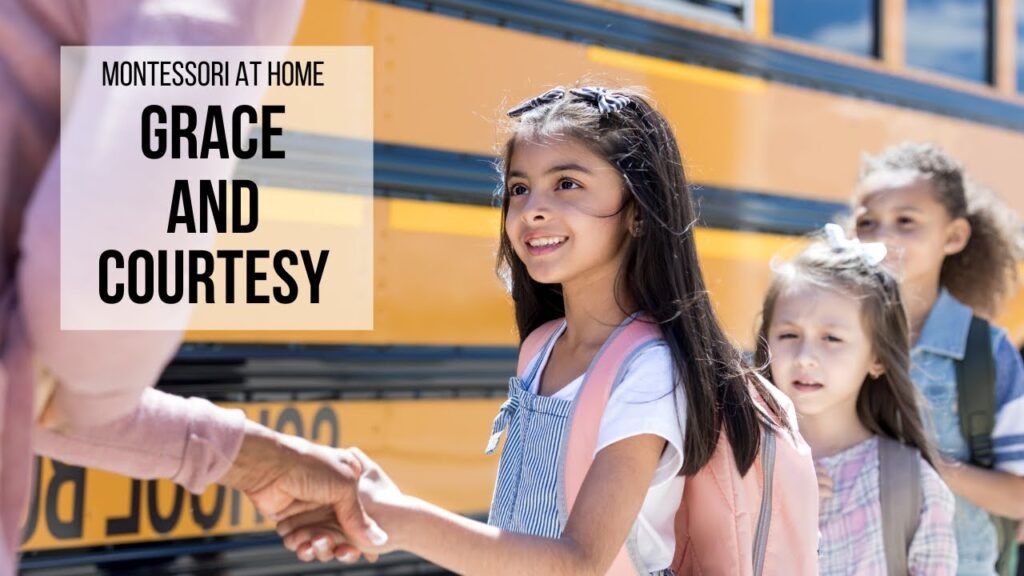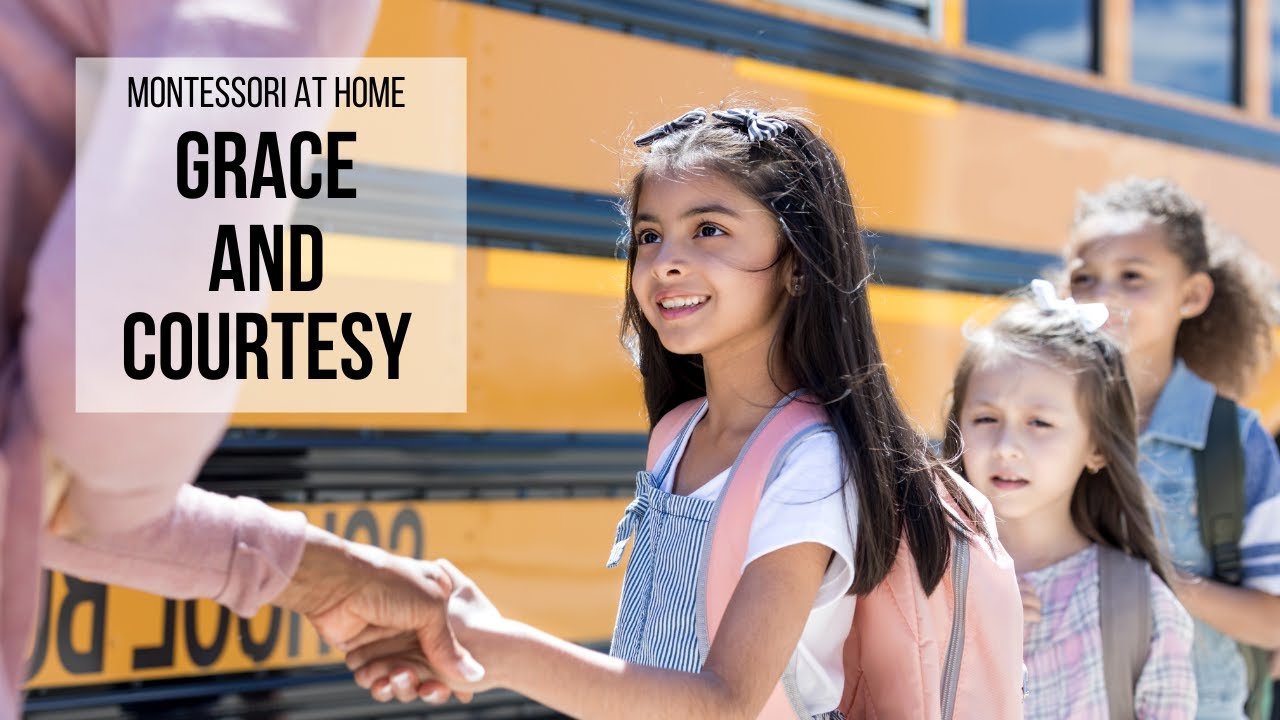Hey there! My name is Ashley, and I’m a mom of two adorable girls, Kylie and Mia. Today, I want to talk to you about a crucial aspect of the Montessori approach called “Grace and Courtesy.” Now, I know this topic might not be as commonly discussed in parenting circles, but it plays a significant role in the Montessori classroom curriculum.
So, what exactly does grace and courtesy mean? Well, think of it as manners and positive social skills. It’s all about how we conduct ourselves and interact with others in a kind and respectful way. Children learn these skills from their parents and primary caregivers, making it essential for us to model these behaviors and teach them directly. In this informative video created by Hapa Family, you’ll find plenty of examples of grace and courtesy skills, such as saying please and thank you, greeting others, asking for help, and apologizing. Trust me, by incorporating grace and courtesy into your daily routines, you’ll be nurturing your child’s social development and setting them up for success.

Introduction
Hey there! Are you interested in learning more about the Montessori approach and how it emphasizes grace and courtesy? Well, you’ve come to the right place. In this article, we’ll explore the importance of grace and courtesy in the Montessori approach, what it entails, how children learn these skills from their parents and primary caregivers, explicit lessons in Montessori classrooms, and how you as a parent can teach grace and courtesy at home. So grab a cup of tea, sit back, and let’s dive into the world of Montessori and the power of grace and courtesy.
The Importance of Grace and Courtesy in the Montessori Approach
Grace and courtesy may not be commonly talked about in parenting circles, but they play a vital role in the Montessori approach. In Montessori education, the focus is not solely on academic learning but also on helping children develop as whole individuals. By teaching grace and courtesy, children learn necessary social skills and manners that will serve them throughout their lives. These skills contribute to creating a positive and respectful community in the Montessori classroom and beyond.
What is Grace and Courtesy?
So, what exactly do we mean when we talk about grace and courtesy? Grace and courtesy can be thought of as manners and positive social skills. It refers to how we conduct ourselves and interact with others in a positive and socially acceptable way. It encompasses a wide range of behaviors, including saying please and thank you, greeting others, asking for help, taking turns, and apologizing. By learning and practicing grace and courtesy, children develop empathy, respect for others, and the ability to navigate social interactions with confidence.
Learning Grace and Courtesy from Parents and Primary Caregivers
Children learn many things from their parents and primary caregivers, including grace and courtesy skills. As the most influential individuals in a child’s life, parents have a powerful impact on their child’s development in this area. By modeling these behaviors in their everyday interactions and maintaining consistent expectations, parents can teach their children excellent examples of grace and courtesy. Children absorb everything in their environment, particularly during the absorbent mind period (from birth to six years old). So, your actions and language matter significantly in shaping your child’s behavior.
Explicit Lessons on Grace and Courtesy in Montessori Classrooms
In Montessori classrooms, explicit lessons on grace and courtesy are offered to children right from the start. The Montessori curriculum recognizes the importance of teaching these skills alongside academic subjects. Children are shown how to greet others, say please and thank you, and engage in respectful communication and conflict resolution. These lessons help create a positive and harmonious environment in the classroom, fostering a sense of community and empathy among the children.
Teaching Grace and Courtesy at Home
Now, you may be wondering how you can incorporate grace and courtesy lessons into your home environment. The good news is that the methods are not vastly different from those used in Montessori classrooms. There are primarily two approaches you can take: modeling and direct teaching.
Modeling Grace and Courtesy
Modeling is one of the most effective ways to teach grace and courtesy to your child. Remember, children learn by observing and imitating their parents. By consistently exhibiting grace and courtesy in your own actions, you create a direct and powerful influence on your child’s behavior. Say “please” and “thank you” to them and others, use polite language, and remember to give them your full attention when they’re speaking to you. When your child sees these behaviors modeled consistently, they will begin to internalize them and imitate them over time.
Direct Teaching of Grace and Courtesy Skills
While modeling is crucial, there will inevitably be times when you need to offer more direct lessons on specific grace and courtesy skills. This approach can be useful when addressing particular behaviors or teaching skills that your child has not yet observed or understood fully. For example, if your child has difficulty asking for a turn or interrupting politely, a direct teaching approach might involve explaining and role-playing the appropriate behavior with them. You can also create teachable moments by addressing situations as they arise, such as when your child needs to apologize for a mistake or thank someone for their help.
Examples of Grace and Courtesy Skills
Now, let’s take a look at some examples of grace and courtesy skills you can teach your child, both through modeling and direct teaching:
- Saying please and thank you: Modeling this behavior consistently will help your child understand the importance of expressing gratitude and using polite language.
- Greeting and saying goodbye: Teach your child how to greet others and bid farewell respectfully. Role-playing can be an effective way to practice these skills.
- Asking for a hug: Help your child understand the importance of asking for consent before initiating physical contact with others. Practice this skill through role play and emphasize the importance of respecting others’ boundaries.
- Asking for a turn: Teach your child how to ask for a turn with a toy or activity and how to accept if someone declines. Role-playing and real-life situations with siblings or playmates can provide ample opportunities for learning.
- Interrupting politely: Teach your child how to interrupt without being disruptive or rude. Explain the appropriate way to wait for a pause in the conversation or to say “excuse me” when seeking attention.
- Asking for help: Encourage your child to ask for help when needed and provide them with the language to do so. Let them know that it’s okay to ask for assistance when they need it.
- Carrying things with two hands: Teach your child the importance of carrying objects safely and using two hands, especially if the items are heavy or fragile.
- Apologizing: Teach your child to take responsibility for their actions and apologize when they have hurt someone’s feelings or made a mistake. Show them how to express remorse genuinely and make amends.
Remember, each skill may require a different teaching approach, depending on the situation and your child’s readiness to learn. Be patient and consistent in your teachings, and trust in the process. Over time, you’ll see your child develop these skills and apply them in their daily life.
Conclusion
Grace and courtesy are fundamental aspects of the Montessori approach, emphasizing manners and positive social skills in children. By teaching grace and courtesy, parents and primary caregivers play a significant role in shaping their child’s behavior and creating a respectful and empathetic environment. Modeling these behaviors and offering direct lessons when necessary enables children to acquire essential skills that will benefit them throughout their lives. So, whether you’re a parent, caregiver, or educator, incorporating grace and courtesy into your interactions with children can have a profound impact on their development and their relationships with others.

